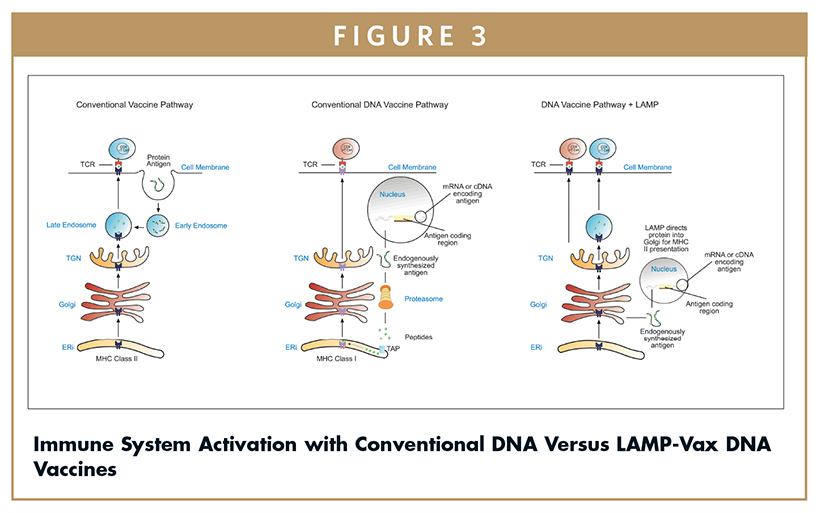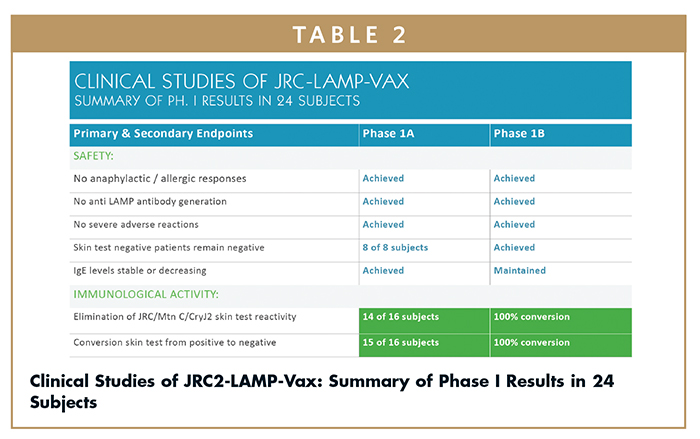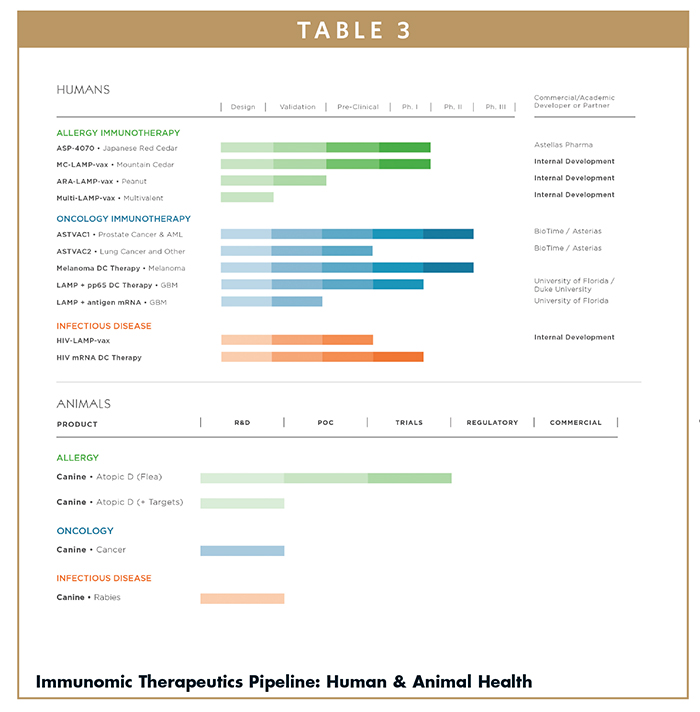Issue:September 2015
DNA VACCINE TECHNOLOGY - A Vaccine Breakthrough That Could Change Lives & Enable Vaccine Development Programs
INTRODUCTION
What if there was the potential for a better and safer treatment for allergies, a less-toxic cancer therapy, or a breakthrough treatment to improve the health of a pet or valuable livestock? What if you could employ a new, patented technology that may make these treatments possible? LAMPVaxTM technology is working toward this goal.
LAMP, which stands for Lysosomal Associated Membrane Protein, is the nucleic acid coding sequence added to DNA – and RNA – vaccines to direct the immune system to effectively respond to vaccination. LAMP diverts the synthesized protein products of DNA- and RNA-based vaccines directly to the lysosome in the dendritic cells, making them readily available to form antigen-MHC-II complexes. These MHC-II complexes, after transport to the cell surface, directly interact with helper T-cells and lead to the production of antibodies and Th1 cytokines, while maintaining enhanced CD8+ cytotoxic T-cell activation. Nucleic acid vaccines with LAMP are being developed to have many of the following advantages:
-Proprietary, intelligent antigen and vaccine design
-Fast, efficient vaccine design and validation (3-5 months)
-Enhanced safety for treatment of allergic diseases
-Excellent stability with long shelf-life
-High manufacturing yields
-Multivalent and multiplex capability
LAMP is potentially the “missing link” to effective DNA and RNA vaccinations because it:
-Is easily added to existing DNA or RNA nucleic acid formulations
-Can be applied to resuscitate failed vaccine programs through improving immunogenicity
-Quickly establishes immunological memory
-Can be used to enhance efficacy of existing peptide or protein vaccines
-Can provide for reformulation of a protein vaccine as a nucleic acid vaccine
IMMUNOMIC THERAPEUTICS & LAMP-VAX
Immunomic Therapeutics, Inc. (ITI), a clinical-stage biotech company, is developing next-generation DNA vaccines based on LAMP technology. The LAMP-Vax platform, initially developed in the laboratory of Dr. J. Thomas August at the Johns Hopkins University School of Medicine, aims to modulate and thereby improve the immune response to nucleic acid vaccines while taking advantage of other key features of nucleic acid vaccines, including simpler overall vaccine design and delivery, safer formulations and low-cost, high-yield manufacturing.
ITI is developing the next generation of DNA vaccines: LAMP-Vax vaccines for allergy, with other applications by collaborators in cancer and infectious disease. Some vaccines will be preventive and others therapeutic, some for human use and some for animal use.
Because of the unique design features of the LAMP platform, these vaccines are designed to activate both the acquired or adaptive immunity mediated by CD4+ T-cells and the cellular immunity mediated by CD8+ T-cells – both arms of the immune system. LAMP provides an elegantly designed solution to direct and enhance antigen processing and presentation, which in turn, aims to increase the immunogenicity of DNA vaccines. ITI’s LAMP vaccines can complement and incorporate other advances and developments in next-generation DNA vaccine design, manufacturing, and delivery, as outlined further.
INCORPORATING LAMP TECHNOLOGY
Vaccine technologies have been in development since the initial use of killed viral and killed bacterial vaccines, including the first generation of live attenuated viral vaccines (eg, measles, mumps and rubella, and yellow fever); and the second generation of subunit vaccines (defined protein antigens [eg, tetanus toxoid] or recombinant protein vaccines [eg, hepatitis B vaccine]).
The newer third generation of vaccines, such as viral vector vaccines (eg, adenoviruses) and nucleic acid (DNA and RNA) vaccines, are still in development as protective and therapeutic vaccines for humans. For animals, next-generation vaccines have been licensed that are protective against West Nile virus in horses and infectious hematopoietic necrosis virus in salmon. There are also therapeutic vaccines for melanoma in dogs and for growth augmentation in swine.1,2 Table 1 compares the various features of different generations of vaccine technologies.
Next-generation nucleic acid vaccines deliver a non-viral plasmid DNA or mRNA sequence into target tissue, where the encoded protein is synthesized within transfected cells, producing significant quantities of the antigenic protein (identified from viral, bacterial, or parasitic genomes or from tumors) that ideally offers protective or therapeutic immunity.3
Upon vaccination, the DNA plasmid is taken up by target cells, and the plasmid vector gains entry to the cell nucleus, where the encoded DNA sequences are transcribed and then translated into the antigenic protein. By delivering into an Antigen Presenting Cell (APC)-rich area of the body, such as the skin, the vector may transfect an APC, allowing the expressed antigen to be directly presented to both CD8+ cytotoxic and CD4+ helper T-cells by MHC class I or II presentation.
If the vector transfects a non-APC, antigen presentation may occur through cross presentation (indirect route).4 Upon delivery of the plasmid to a target organism, the plasmid transfects either non-APCs (indirect route) or APCs (direct route). After the plasmid gains access to the transfected cell’s nucleus, the encoded antigen is expressed as mRNA, exported from the nucleus and translated into an antigenic protein. By encoding the antigen with LAMP-Vax, the antigen-LAMP fusion protein is routed for endosomal processing for efficient access to MHC-II containing intracellular vesicles. The antigen can then be presented by MHC I or MHC II either directly in the case of APC cell transfection or indirectly by cross presentation to proximal APCs after the APC captures secreted antigen. Figure 1 depicts the process of DNA vaccination and the direct versus indirect routes of antigen presentation.
Recently, new ancillary technologies have come into play that may enable DNA vaccines to achieve enhanced are being co-developed with DNA vaccines to increase the efficiency of gene transfer. Techniques such as electroporation aim to deliver more DNA into the cells and thereby achieve higher antigen expression, which is believed by some researchers to correlate with improved humoral and cellular immunity. Innovations in plasmid backbone and antigen design have also greatly improved DNA vaccine performance. By building on these improved plasmid backbones, next-generation DNA vaccines can realize substantially increased antigen expression level and duration, improve manufacturing yield and quality, and address regulatory concerns by eliminating antibiotic selection markers through use of noncoding RNA selection markers.
IMMUNOMODULATORY MECHANISM OF LAMP
LAMP Technology advances the development of nucleic acid vaccines by using the cell’s own mechanism to navigate antigens through the cell, enabling the delivery of the antigen directly to the intracellular organelle essential for effective immune system presentation. In this way, LAMP-mediated vaccines direct the immune system to effectively respond to vaccination by diverting the synthesized protein products of DNA- and RNA-based vaccines into the MHC-II/lysosomal compartment of APCs. The benefit of MHC-II trafficking is the efficient formation of antigen/epitope-MHC-II complexes, which after transport to the cell surface, activate helper T-cells. This begins a cascade of events that lead the adaptive arm of the immune system to produce antibodies, create Th1-biased memory T-cells, and maintain enhanced CD8+ cytotoxic T-cell activation.
In a simplified model of typical vaccination, exogenous antigens from infectious agents are delivered and then taken up through pinocytosis by APCs, which process the antigen for presentation to CD4+ T-cells through MHC-II-antigen complexes, leading to B cell activation and production of antibodies. Concurrently, APCs process antigens for presentation with MHC-I to activate CD8+ cytotoxic T-cells (CTLs), which are then permitted to destroy infected and diseased cells.3
DNA vaccines are often administered to somatic cells, such as muscle, which do not express MHC-II. Thus, when the encoded protein is synthesized, it is processed for presentation with MHC-I complexes to stimulate CTLs. Antibody production without antigen presentation through MHC-II can be weak. To address this, Dr. August and colleagues used the natural trafficking pattern of LAMP to divert the internally synthesized protein antigens to MHC-II-containing lysosomal vesicles. The process of LAMP activation of APCs and presentation on MHC-II to CD4+ T cells is outlined in Figure 2.
Because the diversion of internally synthesized antigens with LAMP-Vax is not total, two arms of the adaptive immune system are promoted by LAMP: the “outside-in” of MHC-I, resulting primarily in CD8+T cell activation, and the “inside-out” presentation through MHC-II, resulting in CD4+ T cell activation.
PREVIOUS APPLICATIONS OF LAMP & CLINICAL SUCCESS
LAMP technology has been incorporated into the design of several DNA and RNA vaccines that have been tested in clinical trials with hundreds of patients and have been shown to enhance the human immune response.
Allergy
Immunotherapy for the treatment of allergies has the potential to significantly reduce the dependence on drugs, such as Benadryl, Claritin, and other drugs that treat symptoms only. Immunotherapy can be accomplished by reversing the “net allergic charge” in the immune system, moving from an IgE/Th2 allergenic response to an IgG/Th1 response. Standard immunotherapy involves subcutaneous delivery of small amounts of allergen over many months or years of continuous therapy. It often involves 100 or more shots. More recently, allergens have been formulated as sublingual drops that are taken daily or weekly for up to several years. With this formulation, the risk of severe adverse events, including anaphylaxis, remains because conventional immunotherapy utilizes allergen or allergenic proteins.
In contrast, LAMP-Vax allergy vaccine immunotherapy aims to offer a novel approach that requires few shots (four have been used in ITI’s Phase IA,IB, and IC studies with JRC-LAMP-Vax, at times with a fifth “booster” shot). Further, it is believed that LAMP-Vax does not expose the patient to free allergen, potentially increasing the safety of the therapy.
ITI is currently developing several allergy vaccines, including ASP-4070 to treat Japanese red cedar allergy, and ARA-LAMP-Vax to treat peanut allergy. LAMP-Vax has been safely applied in several human clinical trials with favorable results and potential immune response using a well-established biomarker, and further in model animal systems for flea allergen, red cedar allergens, and peanut allergens, ITI has observed a strong Th1 response to these potent allergens following LAMP-Vax immunotherapy.
The company completed Phase IA and 1B trials for the first-generation Japanese Red Cedar (JRC) allergy vaccine, ASP4070 (formerly known as JRC-LAMP-Vax), in Q2 2013 and Q4 2013, respectively, and completed its Phase IC trial in 2015. In ITI’s first human study for Japanese red cedar allergy (or JRC) it was observed that the LAMP-Vax therapy reversed the allergen-specific skin test reaction of all the allergic subjects. Further, the allergy vaccine therapy induced conversion of non-related allergens, suggesting a potential systemic response. Summary results of the Phase IA and IB studies are included in Table 2.
ITI has already received a validation of the potential of its technology platform through a recent significant license of ASP4070, the full Japanese red cedar allergy vaccine formulation that targets the two main JRC allergens. Astellas Pharmaceutical, Inc. has entered into an exclusive license agreement for Japan to develop and commercialize ASP4070. Astellas recently initiated a Phase I trial of ASP4070 in Japan in Q3 of this year.
Under the agreement, Astellas is responsible for developing and commercializing ASP4070 in Japan, where Japanese red cedar pollinosis is endemic. Astellas will lead and fund clinical trial development costs and supporting development expenses for Japan. Immunomic Therapeutics also granted Astellas an exclusive option to negotiate a license for additional LAMPVax DNA vaccines to treat allergy indications other than Japanese red cedar pollinosis in Japan.
Meanwhile, ARA-LAMP-Vax, to address peanut allergy and anaphylaxis, is moving forward in preclinical development in the United States. The innovative LAMP platform and the promise it holds enabled the company to garner the interest of members the community working in food allergy research. ARA-LAMP-Vax was successfully tested in Dr. Hugh Sampson’s lab using an animal model of food allergy. A second study is underway to expand on the immunological profiling of the vaccine, while the company prepares the vaccine for entering clinical development in either late 2015 or early 2016.
ITI’s vision is to exploit the response to dominant allergens to create universal/multivalent allergy vaccines that would address entire classes of allergens, and enable ITI to eventually treat most allergens with just a few doses and potentially annual maintenance boosters. Figure 4 summarizes the approach to creating allergy therapy classes with the LAMP vaccine platform, and how LAMP multivalent formulations could potentially simplify the current paradigm of allergy immunotherapy using the 900+ extracts on the market.
Oncology
Cancer immunotherapies, including vaccines, are novel investigational cancer therapies. As with traditional vaccination, the goal of cancer immunotherapy is to stimulate the body’s immune system and overcome cancer’s natural resistance to immune system-mediated cell death. Some current treatment modalities involve combining cancer vaccines with checkpoint inhibitors, using, for example, antibody therapy against CTLA-3 and PD-1/PDL-1, as well as other active immunotherapies.
Cancer vaccines are designed to generate a robust effector and a memory CTL response against antigens that are unique to a particular type of tumor, which results in destroying antigen-expressing tumor cells and establishing long-lasting immune-surveillance. Because of the requirement for CD4+ Th cells for effective T-cell memory (TCM) generation and the absence of CD4+ activation in most DNA/mRNA vaccination strategies, LAMP-Vax has promising potential and is being explored by ITI in multiple cancer types as a broadly applicable immunotherapy platform to induce antigen-specific CD4+ and CD8+ effector and memory cells.
ITI is exploring mechanisms to expand into the therapeutic oncology arena. LAMP-Vax has been advanced into multiple Phase I/II clinical trials with academic and corporate partners for use in patients diagnosed with Glioblastoma (GBM), Acute Myeloid Leukemia (AML), and melanoma. Most recently, it was announced that the LAMP+telomerase-based therapy that previously showed excellent results in prostate cancer and AML human trials is now moving forward in clinical development for AML as well as being applied to lung cancer, using a universal dendritic cell (DC) line, which greatly improves logistical and commercial considerations beyond current FDA-approved DC therapies such as ProvengeTM. The therapeutic mRNA used to load the universal DC vaccine includes the LAMP element to stimulate antigen-specific CD4+ and CD8+ T-cell responses against the promising cancer antigen hTERT. ITI previously granted a license to Geron to study LAMP+telomerase formulations in oncology. Subsequently, Geron granted a sublicense to Asterias Biotherapeutics Inc., who is now moving it forward in clinical development in collaboration with Cancer Research Technology (CRT).5,6
Animal Health
As of 2011, five DNA vaccines had been approved for sale in animal health indications. ITI, recognizing the significant opportunity to leverage the preclinical work done with LAMP technology in a variety of animal diseases, chose to join the surge of applications to veterinary vaccines. The company is currently focused on allergies for companion animals. In paralell, the pipeline below shows several other LAMP-DNA formulations in development for oncology and infectious disease for companion and herd animals.
Phase IA/IB Study in Allergy by ITI – Now Partnered With Astellas Pharma, Inc.
-24 subjects treated with JRC-LAMPVax (no SAEs observed)
-100% reversal of skin test results observed
-IgE levels decreased following treatment, while IgG levels increased
Phase II In Leukemia (AML) With Licensing Partner Asterias
-21 subjects treated with clinical effect on survival (no SAEs reported)
Phase I/II Melanoma With Academic Collaborator
-Over 90 subjects treated with strong CD4+ response (no SAEs reported)
Various Phase I Studies in Glioblastoma by Academic Researchers
-Phase I studies conducted at Duke University w/LAMP in a LAMP-pp65-mRNA transfected DC therapy in Glioblastoma with clinically improved outcomes
SUMMARY
ITI has a robust pipeline with several clinical and preclinical vaccines in internal development and access to options from worldwide research laboratories. LAMP immunotherapies have been successfully used in Phase I and II clinical studies, and trial results show it is safe and effective for patients with prostate cancer, AML, melanoma, and pollen allergy. The company has already established commercial licenses with Geron/Asterias/BioTime for oncology and Astellas for JRC-LAMP-Vax and potentially other allergy vaccines. The pipeline (Table 3) shows the various products that are in development with LAMP. ITI has already established commercial licenses with Geron/Asterias/BioTime for oncology and, most recently, Astellas for JRC-LAMPVax and potentially other allergy vaccines. Several other products are currently available for collaboration and/or out license.
To view this issue and all back issues online, please visit www.drug-dev.com.
REFERENCES
1. K Salonius, N Simard, R Harland, Jb Ulmer. The road to licensure of a DNA vaccine. Curr Opin Investig Drugs. 2007;8(8):635-641.
2. Kutzler MA, Weiner DB. DNA vaccines: ready for prime time? Nat Rev Genet. 2008;9(10):776-788. Doi:10.1038/Nrg2432.
3. Lu Y, Raviprakash K, Leao LC, Chikhlikar PR, Ewing D, Anwar A, Chougnet C, Murphy G, Hayes CG, August TJ, Marques ET, Jr. Department of Pharmacology & Molecular Sciences, The Johns Hopkins School of Medicine, 2003;21:2178-2189.
4. Lu Y. Lysosomal targeting and genetic/DNA vaccines development. Discov Med. 2003;3(18):54-55.
5. Williams JA. Improving DNA vaccine performance through vector design. Current Gene Therapy. 2014;14:170-189.
6. Cancer Research UK, CRT partner with Asterias to trail novel immunotherapy treatment for lung cancer. News-Medical net 2014. http://www.newsmedical.net/news/20140911/Cancer-Research-UK-CRT-partner-with-Asterias-to-trail-novel-immunotherapytreatment-for-lung-cancer.aspx. Published September 2014. Accessed February 2015.

Dr. William Hearl is the Founder, President and Chief Executive Officer of Immunomic Therapeutics, Inc., a privately held clinical stage biotechnology company based in Hershey, PA with lab facilities in Rockville, MD. Dr. Hearl’s experience in intellectual property management and business development led to the speedy sub-license of the LAMP Technology platform to the Geron Corporation shortly after formally beginning operations at ITI in 2006. His vision for the technology platform later led to the successful clinical development of JRC-LAMP-vax and ultimately to the license of this product to Astellas Pharma in 2015 in a $70+ million deal. Prior to founding ITI, Dr. Hearl also founded Capital Genomix, Inc., a genomic tools company that utilized two novel technologies for the identification and then characterization of genes associated with disease. He was also the VP of Research & Development at Kirkegaard & Perry Labs and a Section Leader at Life Technologies. He earned his PhD in Biochemistry from the University of Tennessee (Oak Ridge, Knoxville) and holds multiple patents and patents pending in the field of genetic immunization.
Total Page Views: 9346
























